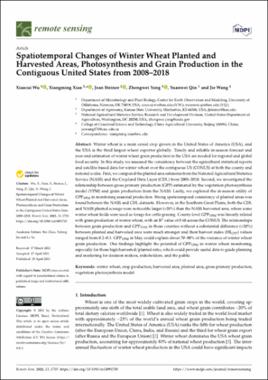| dc.contributor.author | Wu, Xiaocui | |
| dc.contributor.author | Xiao, Xiangming | |
| dc.contributor.author | Steiner, Jean | |
| dc.contributor.author | Yang, Zhengwei | |
| dc.contributor.author | Qin, Yuanwei | |
| dc.contributor.author | Wang, Jie | |
| dc.date.accessioned | 2021-06-25T20:09:31Z | |
| dc.date.available | 2021-06-25T20:09:31Z | |
| dc.date.issued | 2021-04-29 | |
| dc.identifier.citation | Wu X, Xiao X, Steiner J, Yang Z, Qin Y, Wang J. Spatiotemporal Changes of Winter Wheat Planted and Harvested Areas, Photosynthesis and Grain Production in the Contiguous United States from 2008–2018. Remote Sensing. 2021; 13(9):1735. https://doi.org/10.3390/rs13091735 | en_US |
| dc.identifier.uri | https://hdl.handle.net/11244/330096 | |
| dc.description.abstract | Winter wheat is a main cereal crop grown in the United States of America (USA), and the USA is the third largest wheat exporter globally. Timely and reliable in-season forecast and year-end estimation of winter wheat grain production in the USA are needed for regional and global food security. In this study, we assessed the consistency between the agricultural statistical reports and satellite-based data for winter wheat over the contiguous US (CONUS) at both the county and national scales. First, we compared the planted area estimates from the National Agricultural Statistics Service (NASS) and the Cropland Data Layer (CDL) from 2008–2018. Second, we investigated the relationship between gross primary production (GPP) estimated by the vegetation photosynthesis model (VPM) and grain production from the NASS. Lastly, we explored the in-season utility of GPPVPM in monitoring seasonal production. Strong spatiotemporal consistency of planted areas was found between the NASS and CDL datasets. However, in the Southern Great Plains, both the CDL and NASS planted acreage were noticeable larger (>20%) than the NASS harvested area, where some winter wheat fields were used as forage for cattle grazing. County-level GPPVPM was linearly related with grain production of winter wheat, with an R2 value of 0.68 across the CONUS. The relationships between grain production and GPPVPM in those counties without a substantial difference (<20%) between planted and harvested area were much stronger and their harvest index (HIGPP) values ranged from 0.2–0.3. GPPVPM in May could explain about 70–90% of the variance of winter wheat grain production. Our findings highlight the potential of GPPVPM in winter wheat monitoring, especially for those high harvested/planted ratio, which could provide useful data to guide planning and marketing for decision makers, stakeholders, and the public. | en_US |
| dc.description.sponsorship | This research was supported in part by research grants from the USDA National Institute of Food and Agriculture (NIFA, 2016-68002-24967), the US National Science Foundation EPSCoR program (IIA-1946093, IIA-1920946), and the NASA Geostationary Carbon Cycle Observatory (GeoCarb) Mission (GeoCarb Contract # 80LARC17C0001). Open Access fees paid for in whole or in part by the University of Oklahoma Libraries. | en_US |
| dc.language | en_US | en_US |
| dc.rights | Attribution 4.0 International | * |
| dc.rights.uri | https://creativecommons.org/licenses/by/4.0/ | * |
| dc.subject | Winter wheat | en_US |
| dc.subject | Crop production | en_US |
| dc.subject | Harvested area | en_US |
| dc.subject | Planted area | en_US |
| dc.subject | Gross primary production | en_US |
| dc.subject | Vegetation photosynthesis model | en_US |
| dc.title | Spatiotemporal Changes of Winter Wheat Planted and Harvested Areas, Photosynthesis and Grain Production in the Contiguous United States from 2008–2018 | en_US |
| dc.type | Article | en_US |
| dc.description.peerreview | Yes | en_US |
| dc.identifier.doi | 10.3390/rs13091735 | en_US |
| ou.group | College of Arts and Sciences::Department of Microbiology and Plant Biology | en_US |

